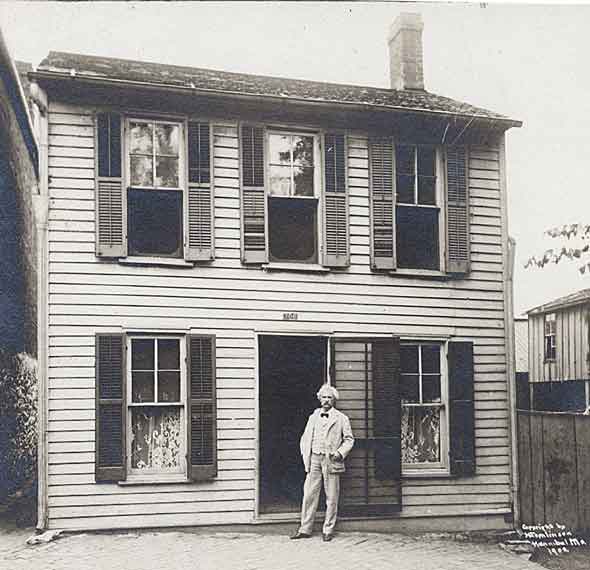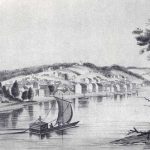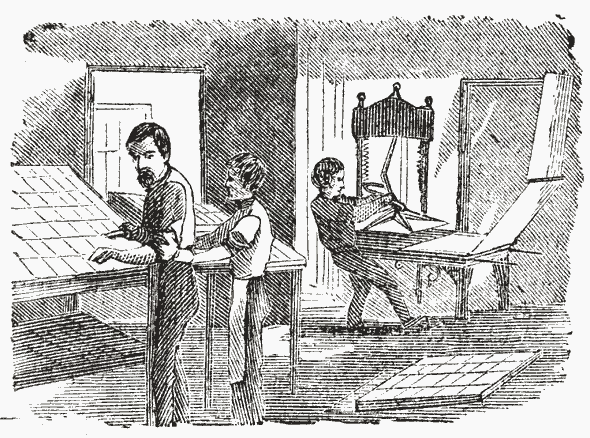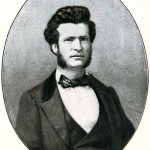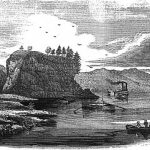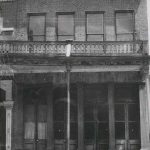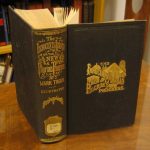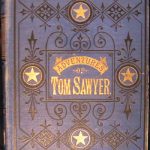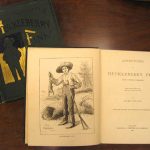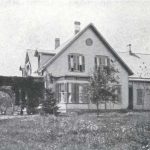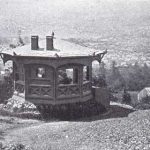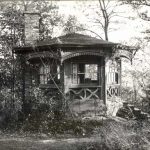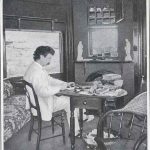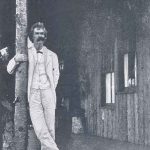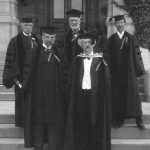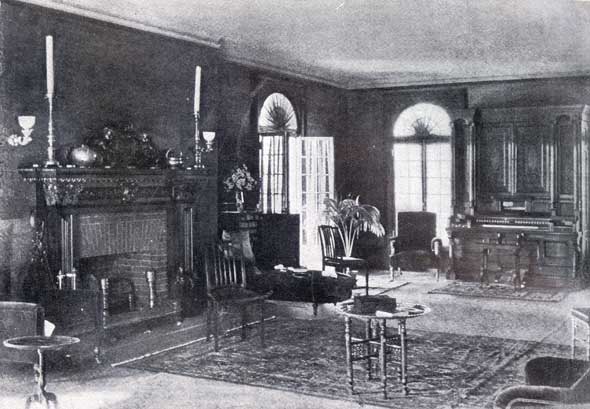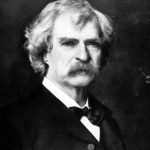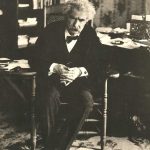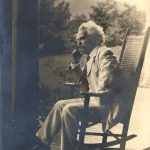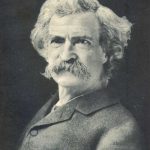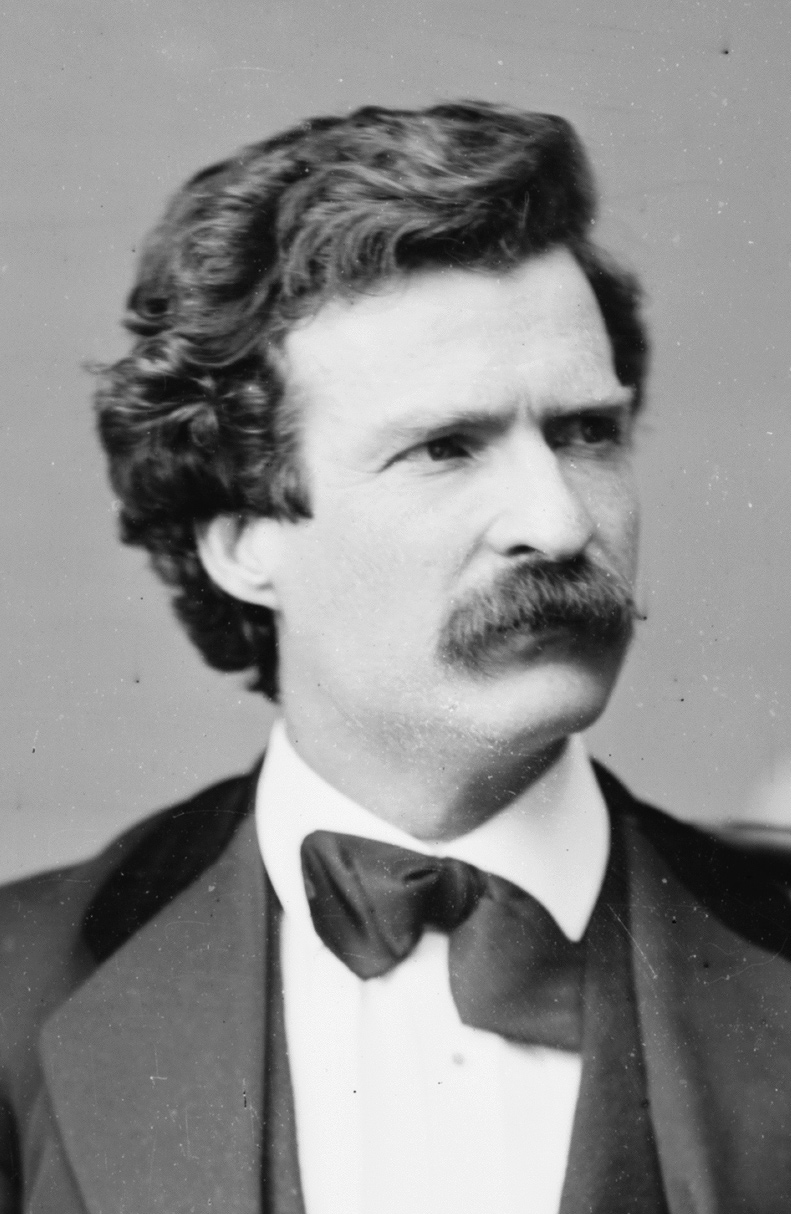
Mark Twain
Introduction
Samuel Langhorne Clemens, also known as Mark Twain, was a major American writer from Missouri. His stories and novels are famous for their humor, vivid details, and memorable characters. His best-known works are The Adventures of Tom Sawyer and The Adventures of Huckleberry Finn, both classics in American literature.
Early Years and Education
Samuel Langhorne Clemens was born in Florida, Missouri, on November 30, 1835. He was the sixth of seven children of John Marshall Clemens and Jane Lampton. In 1839, when Sam was four, he and his family moved to nearby Hannibal. His father thought Hannibal would be a more prosperous place for his business. Sam spent his childhood in this port village nestled on the banks of the Mississippi River. His memories of growing up swimming, fishing, playing pirates, and pulling pranks there made this small Missouri town world-famous.
Sam’s family never had much money. They struggled financially, and when his father died of pneumonia in 1847, life got even tougher. Sam was only twelve and took a number of odd jobs in Hannibal to help his family. He also continued his schooling. From the very beginning, Sam worked in the field of writing called journalism. First, he was a printer’s devil for the Missouri Courier. In 1851 he became a typesetter and editorial assistant at the Western Union, a local paper owned by his older brother, Orion. Sam published his first known sketch, “A Gallant Fireman,” in this paper. In 1853 Sam left Hannibal to work at a series of typesetting jobs in various cities including St. Louis, New York City, and Philadelphia. Then he returned to the Midwest in 1854, working in St. Louis again, Keokuk, and Cincinnati. In Keokuk, Iowa, he worked with Orion at his new paper, the Keokuk Journal.
The Cub Riverboat Pilot Becomes Mark Twain
In 1857, at the age of twenty-two, Sam Clemens boarded a steamboat and headed to New Orleans. He planned to take a trip to South America. Instead, he met the steamboat pilot Horace Bixby, who agreed to let Clemens train with him as a riverboat pilot for a fee of five hundred dollars. For the next two years, Clemens learned how to pilot a riverboat on the Mississippi River. He gained his piloting license in April 1859 and made a good living until the outbreak of the Civil War in April 1861 when all commercial traffic on the river stopped. Clemens then joined the Marion Rangers, a group of Confederate volunteers that disbanded after only two weeks.
In the summer of 1861, President Abraham Lincoln appointed Orion Clemens territorial secretary of Nevada. Sam joined his brother, and together they headed west by stagecoach. When they arrived in Nevada, Clemens worked for Orion for a while, but thought he could make a fortune mining for silver or gold. Though he tried to strike it rich, Clemens failed and returned to journalism, this time as a reporter. He joined the Virginia City Territorial Enterprise in 1862 and was paid $25 a week for various kinds of articles, both serious reports and humorous pieces. In 1863 he began signing his name with the pseudonym “Mark Twain,” a river term meaning “two fathoms deep.” Mark Twain would be Clemens’s pen name for the rest of his life.
Literary Fame
In 1864 Clemens moved to San Francisco and worked for various newspapers. When his short story “Jim Smiley and His Jumping Frog” was published and widely circulated in 1865 by the Saturday Press of New York, Mark Twain became a nationally known humorist. He gave his first public lecture in October 1866 and embarked on a lecture tour in the western states to make money and promote his career. Clemens had a natural talent for telling stories and making speeches. He would lecture on and off for the rest of his life.
In 1867, Clemens set sail as a traveling correspondent on a grand tour of Europe and the Mideast for the San Francisco Alto California. His reports of this journey later became his first best-selling book, Innocents Abroad, published in 1869. After this journey, Clemens met Olivia Langdon of Elmira, New York. They married in 1870 and soon settled in Hartford, Connecticut. Together they had four children: a son, Langdon, who died as an infant, and three daughters—Susy, Clara, and Jean.
It was at their house in Hartford that Clemens turned from journalism to writing the books and novels that made him famous. In 1872 he published Roughing It, an autobiographical account of his years in the West. He published The Adventures of Tom Sawyer in 1876 and his masterpiece, The Adventures of Huckleberry Finn, in 1884. Clemens set both of these novels in his native Missouri and drew heavily on his boyhood memories of growing up in Hannibal. He examined American culture on the edge of the frontier and dealt seriously with such issues as slavery, poverty, and class differences. Clemens’s natural wit and keen observations of human nature—developed and perfected during his years as a journalist—found full expression in his fiction.
Quarry Farm in Elmira, New York
Samuel Clemens and his family lived for extended periods of time at Quarry Farm in Elmira, New York. The house belonged to Olivia Clemens’s adopted sister, Susan Crane. All three of Clemens’s daughters were born in the Quarry Farm house.
Samuel and Olivia Clemens’s children were Langdon (November 7, 1870–June 2, 1872), Olivia Susan “Susy” (May 19, 1872–August 18, 1896), Clara Langdon (June 8, 1874–November 19, 1962), and Jane Lampton “Jean” (July 26, 1880–December 24, 1909).
Failures and Losses
Despite his great literary successes, Samuel Clemens was unlucky in business. He had a strong, recurrent desire to invest in products and projects that often failed, such as the Paige typesetter, an automatic typesetting machine. In fact, Clemens did much of his writing and lecturing to pay off his debts. He and his family moved to Europe in 1891 to live more cheaply and to improve his wife’s health. Then in 1896, Clemens suffered the first of a series of devastating personal losses. While he was lecturing in England, Clemens’s daughter Susy died of spinal meningitis. During the next decade, Clemens would suffer the loss of his wife, Livy, in 1904 and his second daughter, Jean, in 1909.
Clemens's Legacy
Samuel Clemens returned to the United States in 1900. He was greeted by a supportive public that admired his work. In 1902 he traveled to Missouri for the last time to accept an honorary degree from the University of Missouri in Columbia. While in his home state, Clemens also visited St. Louis and returned to Hannibal. There he took a short trip on the Mississippi River with his old friend and instructor Horace Bixby.
The writings of Mark Twain endure on bookshelves and in the hearts and minds of readers around the world. In his sketches, articles, stories, and novels, he captured the flavor and spirit of America during the late nineteenth century. More importantly, he wrote eloquently about universal themes that affect people of all times. His wit, combined with a deep sympathy for innocent and well-meaning people, came from his humble origins in Missouri. Clemens died at Stormfield on April 21, 1910, at the age of 74. He is buried in Woodlawn Cemetery in Elmira, New York, next to his wife and children. His pen name lives on in his books, in an annual book award, and in the vast national forest in Missouri that is named in his honor.
Clemens in his Last Years
Text by Carlynn Trout with research assistance by Jillian Hartke
References and Resources
For more information about Mark Twain’s life and career, see the following resources:
Society Resources
The following is a selected list of books, articles, and manuscripts about Mark Twain in the research centers of The State Historical Society of Missouri. The Society’s call numbers follow the citations in brackets.
Articles from the Missouri Historical Review
- Armstrong, C. J. “Mark Twain’s Early Writings Discovered.” v. 24. no. 4 (July 1930), pp. 485-501.
- Bidewell, George Ivan. “Mark Twain’s Florida Years.” v. 40, no. 2 (January 1946), pp. 159-173.
- Boeser, Linda. “Two Comstock Journalists: Samuel L. Clemens and William L. Wright as Reporters and Authors.” v. 59, no. 4 (July 1965), pp. 428-438.
- Clemens, Cyril. “The True Character of Mark Twain’s Wife.” v. 24, no. 1 (October 1929), pp. 40-49.
- Clymer, Kenton J. “John Hay and Mark Twain.” v. 67, no. 3 (April 1973), pp. 397-406.
- Dahl, Curtis. “Mark Twain and Ben Ely: Two Missouri Boyhoods.” v. 66, no. 4 (July 1972), pp. 549-566.
- Dains, Mary K. “Thomas Hart Benton’s Huck Finn Illustrations Commemorate Mark Twain.” v. 80, no. 1 (October 1985), pp. 1-13.
- Dunbar, Laverne J. “The Missouri Mark Twain Collection.” v. 19, no. 2 (January 1925), pp. 262-267.
- Jones, Judy Yaeger. “Some Private Advice on Publishers: Correspondence Between Laura C. Redden and Samuel L. Clemens.” v. 93, no. 4 (July 1999), pp. 386-396.
- King, Roy T. “The Mark Twain Centennial, 1835-1935.” v. 29, no. 3 (April 1935), pp. 169-174.
- Mabbott, T. O. “Mark Twain’s Artillery: A Mark Twain Legend.” v. 25, no. 1 (October 1930), pp. 23-29.
- Mattson, J. Stanley. “Twain’s Last Months on the Mississippi.” v. 62, no. 4 (July 1968), pp. 398-409.
- Saum, Lewis O. “Colonel Donan, Mark Twain and a Campaign That Failed.” v. 87, no. 2 (January 1993), pp. 131-149.
- Shoemaker, Floyd C. “Mark Twain, America’s Most Widely Read Author.” v. 29, no. 3 (April 1935), pp. 165-168.
- Smith, J. Harold. “Mark Twain’s Basic Political Concepts: Men, Parties, Democracy.” v. 59, no. 3 (April 1965), pp. 349-354.
- Spehar, Warren E. “The Walter Scott: A Steamboat Ahead of Its Day.” v. 62, no. 1 (October 1967), pp. 51-52.
- “Thomas Hart Benton’s Original Illustrations For Mark Twain Classics.” v. 75, no. 4 (July 1981), pp. 385-395.
- “Views From the Past: Missouri Landmarks.” v. 71, no. 1 (October 1976), pp. 80-81.
Articles from the Newspaper Collection
- “Hannibal’s Tribute to Samuel L. Clemens – ‘Mark Twain’ – Memorial Services Held at the Presbyterian Church Yesterday Afternoon.” Hannibal Morning Journal. April 26, 1910. p. 1. [A transcription of the memorial service in Hannibal] [Reel # 13585]
- “Mark Twain.” Joplin Globe. December 19, 2005. p. 7B. [Reel # 18141]
- “Mark Twain Dies and Whole World Expresses Grief.” St. Louis Post-Dispatch. April 22, 1910. p. 1, c. 1; p. 4, c. 6 & 7. [Reel # 41956]
- “Mark Twain: A Sketch of the Great Missouri Humorist – His Wife – His Home – Practical Jokes.” Boonville Weekly Advertiser. April 15, 1881. p. 2, c. 1 & 2. [Reel # 1746]
- “Mark Twain’s Marriage.” Boonville Weekly Advertiser. January 10, 1879. p. 7, c. 1. [Reel # 1744]
- “Samuel Langhorne Clemens ‘Mark Twain,’ Dies at Stormfield, near Redding, Conn.” Hannibal Morning Journal. April 22, 1910. p. 1, c. 1. [Reel # 13585]
Books and Articles
- American National Biography. New York: Oxford University Press, 1999. v. 22, pp. 52-60. [REF 920 Am37 v. 22]
- Christensen, Lawrence O., William E. Foley, Gary R. Kremer, and Kenneth H. Winn, eds. Dictionary of Missouri Biography. Columbia: University of Missouri Press, 1999. pp. 193-196. [REF F508 D561]
- Clemens, Clara. My Father, Mark Twain. New York: Harper & Brothers, 1931. [REF IC591 BcL2]
- Clemens, Cyril. Mark Twain for Young People. New York: Whittier Books, 1953. [REF IC591 BcL5mar]
- Dictionary of American Biography. New York: Charles Scribner’s Sons, 1930. v. 4, pp. 192-198. [REF 920 D561 v. 4]
- Howard, Oliver, and Goldena Howard. The Mark Twain Book. Marceline, MO: Walsworth, 1985. [REF IC591 Bhowd]
- Kane, Harnett T. Young Mark Twain and the Mississippi. New York: Random House, 1966. [REF IJ K132y]
- Kirk, Connie Ann. Mark Twain: A Biography. Westport, CT: Greenwood Press, 2004. [REF IC591 Bkir]
- Meltzer, Milton. Mark Twain Himself; A Pictorial Biography. Columbia: University of Missouri Press, 2002. [REF IC591 BMe 2002]
- Neider, Charles. The Autobiography of Mark Twain. New York: Harper & Brothers, 1959. [REF IC591 Bane]
- Powers, Ron. Mark Twain: A Life. New York: Free Press, 2005. [REF IC591 Bpo2]
- Ward, Geoffrey C., Dayton Duncan, and Ken Burns. Mark Twain [An Illustrated Biography]. New York: Alfred A. Knopf, 2001. [REF IC591 Bwar]
- Who Was Who In America. Chicago: A. N. Marquis Co., 1942. v. 1 (1897-1942), p. 230. [REF 920 W6201 v.1]
Manuscript Collection
- Brashear, Margaret M. (1874-1963), Papers, 1868-1962 (C3393)
This collection consists of correspondence, manuscripts, notes, clippings, student papers, and articles of a professor of English at the University of Missouri. She taught classes on Mark Twain and Missouri literature and wrote several books and articles. References to Samuel Langhorne Clemens can be found throughout the collection. - Clemens, Samuel Langhorne (1835-1910), Genealogy (C3133)
Genealogy of three generations of the Clemens family, starting with John Marshall and Jane Lampton Clemens, Samuel Clemens’s parents. Also a brief biography of Mark Twain and descriptions of Florida, Missouri, and Mark Twain State Park. - Clemens, Samuel Langhorne (1835-1910), Papers, 1895-1901 (C2007)
This collection contains a poem entitled “Contract with Mrs. T. K. Beecher, Quarry Farm,” written by Mark Twain on 2 July 1895. Also included is a Mark Twain circular letter to W. L. Howard from New York, 2 May 1901, regretting he could not accept a lecture engagement. An added personal note states he would have made the trip but was permanently tired of travel and hoped he had made his last journey. - Searing, Laura Redden (1839-1923), Papers, 1846-1963 (C2290)
The papers of Laura Redden Searing, a poet and author whose works appeared in numerous newspapers and magazines, consist of correspondence, newspaper clippings, photographs, and her writings. The collection contains two letters written by Clemens, giving her publishing advice.
Outside Resources
These links, which open in another window, will take you outside the Society’s website. The Society is not responsible for the content of the following websites:
- Center for Mark Twain Studies
The Center for Mark Twain Studies at Elmira College in New York is dedicated to supporting education about Samuel Clemens’s life and work, as well as preserving Quarry Farm and the Mark Twain Study. - Mark Twain Birthplace State Historic Site
This website offers information about the Mark Twain Birthplace State Historic Site in Florida, Missouri. - Mark Twain Boyhood Home & Museum
This website offers information about the Mark Twain Museum and Boyhood Home in Hannibal, Missouri. A special teacher section offers lesson plans, and a timeline of Clemen’s life as well as genealogical information on the Clemens family. The museum sometimes offers summer week-long teacher workshops. - Mark Twain: A Film Directed by Ken Burns
Connected with the PBS film by Ken Burns about Mark Twain’s life, this website includes a virtual scrapbook and life chronology. - The Mark Twain House & Museum
This website offers a biography of Clemens as well as information about the house in Hartford, CT, where he raised his family and worked from 1874 to 1891. - Mark Twain: A Look at the Life and Works of Samuel Clemens
This website provides a biography of Clemens as well as other useful information about this Hannibal native. - Mark Twain’s Mississippi
This website provides a fully searchable and indexed digital library of Samuel Clemens’ publications under the name of Mark Twain, placing special emphasis upon Twain’s Mississippi novels and reminiscences (The Adventures of Tom Sawyer, The Adventures of Huckleberry Finn, and Life on the Mississippi). - The Mark Twain Papers & Project
This website offers information about Mark Twain’s private papers and the on-going effort to publish scholarly editions of them and his published works under the title The Works and Papers of Mark Twain.



